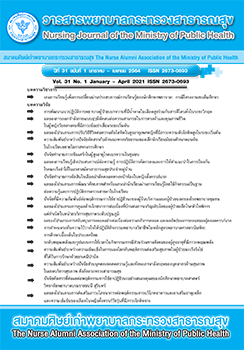Effectiveness of a Continuing Nutrition Care at Home Program on the Growth of Children with Congenital Heart Disease in a Primary Health Care Unit
Main Article Content
Abstract
The purpose of this research and development study were to develop a continuing nutrition care at home program in a primary health care unit and to determine the effectiveness of this program on the growth of children with congenital heart disease (CHD). The sample was recruited by a multi-stage random sampling technique. Ninety participants were categorized into 3 groups including health personnel, caregivers, and children with congenital heart disease. Data were collected from of October 2018 to September 2019 using the research instruments which consisted of the continuing nutrition care at the home program and growth record form for children with CHD. Descriptive statistics and paired t-tests were used for data analyses. The research results found that 66.6% of children with CHD were malnourished, classified as level 2 at 33.3%, level 1 at 20.0%, and level 3 at 13.3%. Those with normal weight and overweight were at 16.7%. When comparing the growth of children with CHD, it was found that the mean weight for age after receiving the program was significantly higher than before receiving the program (t=2.95, p=.006). The mean height for age of children with CHD before and after receiving the program was not significantly different (t=.36, p=.72).
Article Details
บทความและรายงานวิจัยในวารสารพยาบาลกระทรวงสาธารณสุข เป็นความคิดเห็นของ ผู้เขียน มิใช่ของคณะผู้จัดทำ และมิใช่ความรับผิดชอบของสมาคมศิษย์เก่าพยาบาลกระทรวงสาธารณสุข ซึ่งสามารถนำไปอ้างอิงได้
References
2. Chowdhury F, Hoque MM, Ali M, Hossain A. Comparison of growth in children with cyanotic and acyanotic congenital heart disease in a tertiary care hospital. Journal of Bangladesh College of Physicians and Surgeons 2018;36(2):64-9.
3. Soiphet N, Intichoti N, Khrutmuang W, Suanpan N. Care for children with congenital heart disease to prevent respiratory tract infection. Journal of Health and Nursing Research 2019;35(2)26-37. (in Thai)
4. Wangsawat T, Jaisomkom A, Pongjaturawit Y, Piboonrungroj P, Hayeese W, Samael L. Nutritional status and experience of caregiver in food management for children with congenital heart disease aged 0–3 years in southern border provinces. Thai Journal of Cardio-Thoracic Nursing 2019;30(2):82-93. (in Thai)
5. Somchue N, Sanasuttipun W, Srichantaranit A. The effect of a teaching program on knowledge and behaviors of caregivers to promote nutrition in children with acyanotic congenital heart disease. Journal of Nursing Science 2016;34(3):79-93. (in Thai)
6. Petruentong P, Srichantaranit A, Prasopkitikum T. Growth and development in children with congenital heart disease. Songklanagarind Journal of Nursing 2018;38(1):10–21. (in Thai)
7. Bertoletti J, Caroline G. Quality of life and congenital heart disease in childhood and Adolescence. Arp Bras Cariol 2014;102(2):192–8.
8. Wangsawat T, Phiban A, Piboonrungroj P, Hayeese W, Chansintop S, Dereh N, et al. The effect of education program on knowledge and role in the caregiver for children with congenital heart disease aged 0–3 years. Princess of Naradhiwas University Journal 2019;11(3):93-103. (in Thai)
9. Lantin-Hermoso MR, Berger S, Bhatt AB, Richerson JE, Morrow R, Freed MD, et al. The care of children with congenital heart disease in their primary medical home. American Academy of Pediatrics 2017;140(5):1-10.
10. Eagleson K, Campbell M, McAlinden B, Heussler H, Pagel S, Webb K, et al. Congenital heart disease long–term improvement in functional hEalth (CHD LIFE): A partnership programme to improve the long–term functional health of children with congenital heart disease in Queensland. Journal of Paediatrics and Child Health 2020;56:1003-9.
11. Donabedian A. The definition of quality and approaches to its assessment. Michigan: Health Administration Press;1980.
12. Kerlinger NF. Foundations of behavioral research. 3rd ed. New York: Holt Rinehard & Winston;1986.
13. Ratanachuak S. Pediatric nutrition handbook. 3rd ed. Bangkok: Chaicharoen;2012.
14. Daymont C, Neal A, Prosnitz A, Cohen MS. Growth in children with congenital heart disease. Pediatrics. 2013;131(1):236-42.
15. Eman M, Alshayma AA, Naglaa A. Growth in children with congenital heart disease. Zagazig University Medical Journal 2018; 24(5):365–70.
16. Mahamad P. Health care service model for the bed bound by community participation, Sungaikolok sub district, Narathiwat 2019;10(2):51-63. (in Thai)
17. Yingrengreung S, Rachawat P. Providing care for children with congenital heart disease for good quality of life. The Journal of Boromarajonni College of Nursing, Nakhonratchasima 2014;20(1):5-10. (in Thai)

